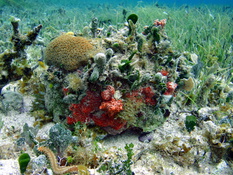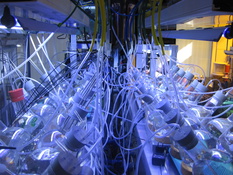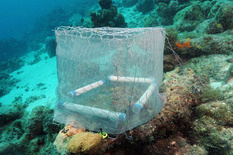Dieser Text ist zur Zeit nur auf Englisch verfügbar...
Environmental change is occurring in many forms as a consequence of increased anthropogenic activities. The Algae and Seagrass Ecology WG focuses on the response of coastal and estuarine seagrasses and macroalgae to abiotic and biotic stressors in their environment through 1) field surveys along environmental gradients through space and time to obtain a broader ecological understanding of how organisms adapt to their environment, 2) controlled field and laboratory experiments under varying stressors to develop a mechanistic understanding of physiological responses at the organism and ecosystem level, and 3) applied studies through integration of macrophytes in mitigation projects.
Environment
In this research theme, we take a broader ecological approach to understanding how organisms function in their natural environment in order to identify groups of organisms of ecological relevance. This can be done by monitoring environmental variables across systems on the local and global scales and measuring changes in abundances or density of the populations and organism and community traits through space and time. Some of the most important stressors impacting aquatic plant ecosystems today are changes in nutrient inputs, which drive increases in primary production and decreases in light availability within the water-column, and climate change, which impacts both temperature and pH and can influence species distribution range and competition. Research methods include collecting datasets on physical, chemical, and biological variables within the water and sediment combined with species abundances and traits of macrophytes of the selected sites across space and time. Additionally stable isotopic methods are used to detect anthropogenic inputs of nutrients by measuring 15N of various types of macrophytes with different growth rates, representing different time intervals of nutrient impact. These studies will provide scientific knowledge for coastal and aquatic nutrient management decisions at the local level as well as large scale patterns in macrophyte response and distribution ranges at the global scale under future environmental scenarios.
Plant Response
This research theme focuses more in depth on species-specific responses of macrophytes to changes in their environment with the aim to determine their resilience, or ability to cope or resist change, and to identify the mechanisms by which they do this. By understanding species responses to varying environmental conditions, we can better predict how marine communities may look in the future and which groups of organisms or species may dominate under specific environmental conditions. We use a trait-based approach in which morphological, physiological, biochemical, and genetic traits of organisms are measured in field or laboratory experiments under uni- or multi-factor treatments. We focus primarily on nutrients in combination with temperature or CO2 as controlling factors, but also work with light and grazing pressure. Responses of the organisms are measured in short-term (hours to days) or long-term (days to months) experiments depending on the processes. Traits involved in light and nutrient acquisition, energy storage, and defense are among the traits measured to get a better mechanistic understanding of the processes of photosynthetic acclimation and nutrient and carbon uptake, assimilation, and allocation. Measurements are taken with the whole plant or differentiated among tissue types to better understand tissue functions and processes at the cellular level. This research may also feed into the theme Services to identify plants suitable for nutrient bioremediation or climate mitigation projects.
Ecosystem function
Seagrasses provides a wide range of ecosystem functions and services, however, evaluating and quantifying them appropriately for decision-making processes is challenging due to knowledge and methodological gaps. We are developing a framework to evaluate ecosystem functions of seagrasses using a trait-based approach. To do this, we are integrating existing global data on traits and ecological processes from the literature with new data on morphological and physiological traits, correlating traits with their ecological functions, which may be used for assessing the main ecological processes involved. By forming a trait-based description of the organisms within a community, it will help us understand how community compositions reorganize under changing environmental conditions. Additionally, mapping traits at the regional and global scale for the development of an ecosystem function framework can be used by decision-makers to better evaluate ecosystem service potential. We are currently working with an EU network to to synthesize global and European wide seagrass trait data. To link trait data to ecological processes, such as primary production, nutrient uptake and cycling, these processes will additionally be investigated along with traits, through in situ and laboratory incubations using sensor technologies.
Services
The knowledge of how macrophytes influence ecosystem function can be transferred to applied solutions and services. For example, macrophytes are excellent at removing nutrient wastes from coastal waters, either through direct uptake and storage or through microbial processes that occur within their habitats. Additionally they can aid in the mitigation of climate change by capturing and sequestering CO2. This research theme focuses on the potential services of macrophytes both in their natural environment as ecosystem services and through their use in mitigation projects. Aquatic plants and algae have a long history of use by humans as food and many coastal populations depend on aquaculture for their food and livelihoods. We are working on an interdisciplinary research focus area which aims to integrate nature, society, and economy through marine biodiversity and sustainable innovative aquatic production. Our research interests in this focus area are to improve and develop restoration methods to use macrophytes as nutrient filters to reduce nutrient pollution to coastal habitats and to mitigate climate change through enhanced carbon sequestration, and in turn provide a service and benefit to society.








